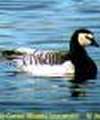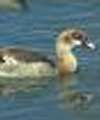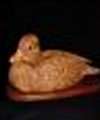Dawlish Lawn
Dawlish Waterfowl
Black Swan
(Chenopsis Atrata)
The black swans of Dawlish were introduced to the town from New Zealand by John Nash, a Dawlish-borne man who emigrated during adulthood but paid frequent visits to the town. The swan has been the town emblem for over forty years.


The black swan is native to Australia and is found throughout much of the south-eastern and south-western parts. It is found on most wetlands, ranging from small well-vegetated freshwater swamps to large, open waters, including bays and inlets. The black swan is fully protected in all states and territories of Australia. The black swan of New Zealand is not native but was introduced from Australia, and is now considered a pest.
In flight, the black swan has a very long slender neck and white flight feathers along the edge of its wings. The flight is slow with slow wing beats, and a high-pitched bugle is often uttered. Male and female have a similar appearance.
Juveniles are grey-brown with black tips to the outer white flight feathers, and cygnets are light grey, downy with grey-black bills and feet.
Barnacle Goose
(Branta Lencopsis)
The barnacle goose a is a small goose with a distinctive cream-coloured cheek patch and is native to Europe. They are herbivores with a relatively simple digestive tract and require high quality plants. They are very selective foragers.


Each barnacle goose finds a mate which they will stay with for their lifetime. The female lays 3 to 5 eggs, and after they are hatched, the babies make their way down to the feeding grounds by themselves. The babies become adults in a period of 7 weeks.
Barnacle geese are very vocal and make a "kaw" sound similar to the yap of a small dog.
Call Duck
(Anas Platyrhyncha)
The Call Duck or Domesticated Mallard is the smallest breed of duck, weighing only 1-1½lbs. They are a domestic duck initially bred to call down the wild mallard to the great traps of the Fenlands of the UK and the marshes of


Holland. Because of this they are also known as 'decoy ducks'. Males are much less vocal than females.
They were introduced to the UK in 1865 from Holland and are thought to have originated from the Far East.
Carolina Duck
(Aix Sponsa)


The Carolina Duck, also known as the Wood Duck, is are one of the most beautiful waterfowl on the lawn. Its scientific name, Aix sponsa, actually means "water bird in bridal dress".
In the 18th and 19th centuries, these ducks were hunted for food and for their decorative feathers. So many were killed that in the early 20th century they were almost extinct.
They lay from March to June and sometimes produce a second clutch after rearing the first clutch. These ducks are promiscuous and hybridisation is common, particularly with the red-crested pochard and the common pochard drake.
Chinese Goose
(Anser Cygnoides)


Chinese geese are perhaps the most graceful and beautiful member of the goose family and are elegant and dignified on both land and water. They descended from the wild swan goose of Asia, hence their long and graceful swanlike necks.
Chinese geese produce nearly twice as many goslings as other geese, laying 40 - 100 white eggs annually. They are alert and vocal and will raise the alarm if a threat is perceived. They feed on many grasses and herbaceous plants.
Crested Duck
(Lophonetta Specularioides)


The powder-puff feathers on the head of the Crested Duck makes it a truly striking bird. It is not known for sure where these unique birds originated from but it is believed that they are decended from the Pekin duck
Adult drakes weigh about 7 pounds, hens around 6. They come in two varieties black and white, although other varieties have been developed by breeders.
The crested gene in these ducks is linked to a lethal condition during incubation. Ducklings carrying both genes (homozygous) for the crest do not survive to hatch.
Egyptian Goose
(Alopochen Aegyptiacus)


Also known as the Large Spotted goose due to a large dark dot on the chest, the Egyptian Goose is a territorial bird with a noisy harsh call used to threaten off other geese.
Pairs generally remain together for long and lasting periods and they will breed at any time of year using the nests of other birds.
They feed mainly on grass.
Lesser White-Fronted Goose
(Anser Erythropus)


The Lesser White-fronted Goose is a small goose with a dark grey-brown plumage and dark bars on its belly. Adults are 53-65 cm long and have a small and short pink bill. Its feet are orange while the wings outstrip the tails edge when they are closed. The bird feeds exclusively on herbaceous plants.
The number of Lesser White-fronted geese has decreased nearly 90 per cent since the early part of the 20th century, leaving the world population at approximately 50,000.
Mandarin Duck
(Aix Galericulata)


In full plumage, the male Mandarin has a crest of orange and cream feathers and a broad white eye-stripe bounded by darker feathers. The female is duller with an overall grey appearance marked by a curving white stripe behind the eye and a series of white blotches underneath. They feed on water plants and grain.
The Mandarin courtship display is very impressive and involves mock-drinking and shaking.
Moorhen
(Gallinula Chloropus)


The moorhen is widely distributed throughout the whole of Europe except northern Scandinavia.
Moorhens feed on insects and their larvae, spiders, small molluscs and the tenderest leaves of duckweed. In the autumn, adult birds add small seeds to their diet.
They nest in rushes, reeds or clumps of grass using dry reeds brought by both partners. Each pair has its own nesting territory, which both birds fiercely defend.
When swimming, the moorhen continually flicks its tail.
Muscovy Duck
(Cairina Moschata)


Muscovy ducks have large talons and long tails. Males are more brightly colored than females, and have red fleshy carnicules on their faces, over their eyes and at the base of their bills. Females have less fleshy carnicules or none at all.
They have a varied diet, feeding on grasses, sedges, aquatic plants (roots, stems, leaves, and seeds), small fish and reptiles, invertebrates (insects, crustaceans, arachnids) and termites.
They prefer to nest in tree cavities but will nest in abandoned nests of large birds, wooden boxes or other man-made elevated cavities.
Pintail
(Anas Acuta)


The male pintail is relatively large duck with a white patch on the underside of the breast area and a long 'pin' tail that can be up to 10" in length. The female is brownish in colour, lacks the 'pin' tail and is less attractive than the drake.
The pintail feeds largely upon bulbous roots, tender shoots, insects and their larvae, worms and snails, and in Autumn various seeds, water plants, and grain
Pintails nest on low but dry, grassy land close to water, usually under the shelter of a bush and lay from seven to ten eggs.
Shelduck
(Tadorna Tadorna)


The common shelduck is a large duck, mainly white with a distinctive chestnut band across the chest and black markings on its back and wings. The head is very dark green and the bill red. Drakes usually have a fleshy knob on the bill in summer, otherwise sexes are alike.
Their diets are very varied and include sand-worms, shellfish, crustaceans and many kinds of seaweed.
Shelducks nest in burrows, usually taking over one made by rabbits and therefore quite some distance from the water's edge. They lay between six and twelve eggs.
Teal
(Anas Crecca)


The drake Teal has a grey body, dark head and white line along the body and a triangular yellow patch at the rear end. The female has a plain grey bill, green patch in the speculum and a pale line along the edge of the tail. Their small size and pointed wings make them fast and agile in flight.
They prefer to seek food on mud flats or shallow marshes and usually feed on vegetative matter consisting of seeds, stems and young leaves. Occasionally they will eat insects, mollusks, and crustaceans.
Teals nest anywhere between 1 to 90 meters from water in depressions on dry ground located at the base of shrubs, under a log, or in dense grass.
Tufted Duck
(Aythya Faligula)


The male tufted duck is immediately recognisable by the pigtail of feathers on its head and its bold black and white plumage. The female tufted duck is black-brown with a small patch of white at the base of the bill and a much smaller pigtail.
Tufted ducks feed on roots, seeds, buds of aquatic plants, clams, snails, aquatic insects, and sometimes amphibians and small fish. They also skim flies and duckweeds on the water surface. They are capable of diving to depths of 2 to 3 metres.
The female duck nests on small islands or on sloped banks under bushes close to water and lays an average of 9 eggs.
Whistling Duck
(Dendro Cygna)


Whistling Ducks differ from most ducks by having long legs, rounder and broader wings and an erect goose-like posture when alert. Males and females look similar, and there is no special breeding plumage.
They prefer shallow water, nibbling on the seeds and shoots of water plants. Occasionally they will eat insects and aquatic invertebrates.
Whistling Ducks nest close to water in dense vegetation such as a bed of tall reeds so their chicks can reach the water immediately after hatching. The female lays 10-12 eggs.
Important Info
You are asked not to feed the waterfowl with white bread (brown is acceptable). Food pellets can be purchased from nearby shops.
Green vegetables and lettuce are a useful addition to the birds diet.














